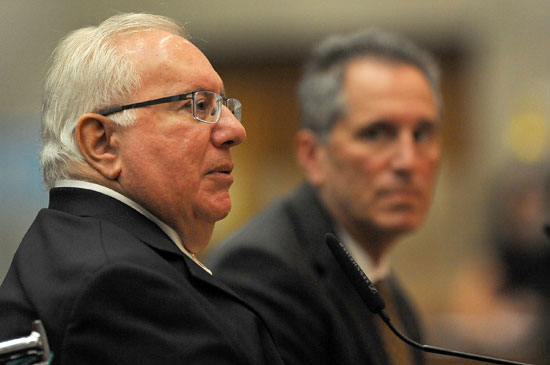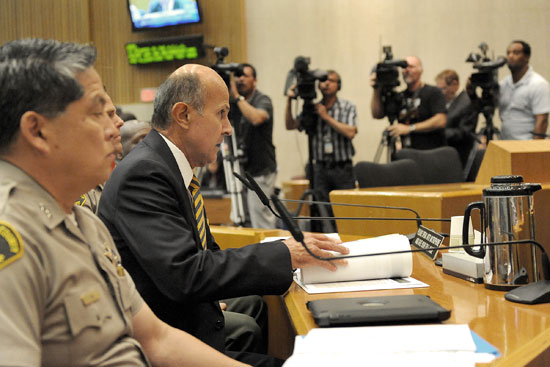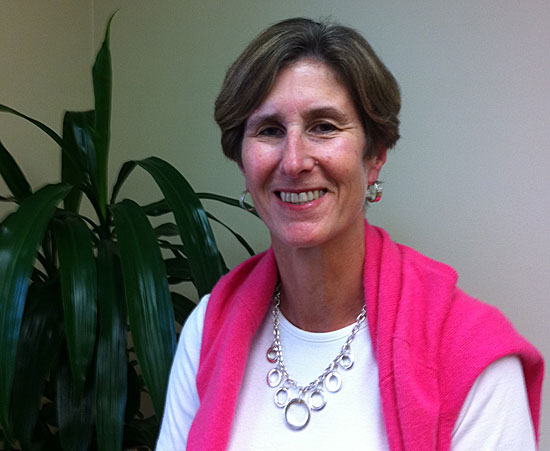It’s “Action!” for new movie museum
October 18, 2012
 The Academy of Motion Picture Arts and Sciences today unveiled an initial public look at the architects’ vision for its new movie museum, billed as the first major institution of its kind in the United States.
The Academy of Motion Picture Arts and Sciences today unveiled an initial public look at the architects’ vision for its new movie museum, billed as the first major institution of its kind in the United States.
One of the drawings, by architects Renzo Piano and Zoltan Pali, depicts a dramatic glass sphere that appears to float behind the museum, which will be located in the grand, 1938 May Co. building on Wilshire Boulevard at Fairfax. The museum, on the Los Angeles County Museum of Art campus, promises to have a “profound impact on the cultural landscape of Los Angeles,” Supervisor Zev Yaroslavsky said in a statement.
In a news release, the Academy announced that $100 million has been raised so far to build the non-profit museum, which will be “dedicated exclusively to the history and ongoing development of motion pictures.” A capital campaign to raise the remaining $150 million is underway.
The nearly 300,000-square-foot museum is set to open in 2016.
Read the full release here.
Illustrations by Renzo Piano Building Workshop
Posted 10/18/12
Mapplethorpe, revisited
October 18, 2012
It was an L.A. coup when some 2,000 photographs by Robert Mapplethorpe ended up with the Los Angeles County Museum of Art and the J. Paul Getty Trust. Now art fans will get their first glimpse of that trove, as two small-but-revealing shows of Mapplethorpe’s work open in the next few days at the museums, with images from the classical to the infamous.
The $30 million-plus collection—which is expected to yield an even bigger and more comprehensive show in 2016 at the two museums—was jointly acquired from the Robert Mapplethorpe Foundation last year.
“[LACMA Director] Michael Govan had worked with the foundation during his time at the Guggenheim in New York,” says LACMA photo department curator Britt Salvesen. “He knew the value of the archives, and knew they would eventually need a repository.
“Flash forward to L.A., where he made the case that if LACMA were to partner with the Getty, they would have an ideal situation,” Salvesen remembers. “At the Getty Research Institute, the artwork would be accessible to researchers and could be seen with other archives that have a relationship to it. At the same time, the two museums would be great repositories for Mapplethorpe’s body of work, because at the Getty, it could be seen in the context of art history and classicism, and at LACMA, it could be seen with the art of the 1980s.”
This month’s shows—opening October 20 at LACMA and October 23 at the Getty Center—represent the first pass at that massive archive, which also includes hundreds of drawings and assemblages by Mapplethorpe, more than 1,000 un-editioned silver gelatin prints, more than 100,000 negatives, several films, voluminous documentation and correspondence, videotaped interviews and more.
As had been the case for most of the artist’s career, at least some of the work will be shown with parental warnings. LACMA’s show—shielded by interior walls and introduced by a pair of quotes from the obscenity trial it set off in 1990—will feature Mapplethorpe’s notorious X,Y and Z Portfolios, three sets of sexually charged, black-and-white photos themed, respectively, around homoerotic sadomasochism, floral studies and African-American male nudes.
Meanwhile at the Getty, another cache of 23 images will span Mapplethorpe’s career from early collages and Polaroids to his signature staged, classic nudes from the 1980s. “In Focus: Robert Mapplethorpe,” also will showcase Mapplethorpe’s social circle, including now-famous photos of his friend and early lover, Patti Smith.
Now regarded as one of the 20th century’s most influential fine art photographers, Mapplethorpe has been a controversial figure in the decades since his death at age 42 from AIDS complications in 1989. Some critics have viewed his stylized, black-and-white portraits and studies as groundbreaking, while others have excoriated their content as exploitative and pornographic.
The portfolios being exhibited at LACMA, for instance, ignited one of the hottest battles of the culture wars in 1990, when the late Sen. Jesse Helms (R-N.C.) denounced the National Endowment of the Arts for having helped underwrite their display in Philadelphia. The ensuing uproar spawned an obscenity trial in Cincinnati. (The museum director was ultimately acquitted.)
The Santa Monica Museum of Art displayed the X Portfolio as part of a restaging of that controversial exhibition in 2000, but otherwise the images have been rarely shown.
Salvesen predicts this month’s shows, and those to come, will move Mapplethorpe’s legacy beyond social controversy toward a broader perspective on his place as an artist. She points to younger artists whose work has built on and responded to Mapplethorpe’s, such as Catherine Opie and Glenn Ligon, and predecessors such as Edward Kienholz, whose work—also once known for its shock value—has stood the test of time.
“We’re trying to point forward in some sense to how Mapplethorpe can be seen from now into the future,” she says, “to the continued influence his work might have on other artists, as well as on our culture and society.”
Posted 10/18/12
Supes step up sheriff scrutiny
October 18, 2012
Confronted with a scathing report on brutality and mismanagement in the Los Angeles County jails, Sheriff Lee Baca has repeatedly insisted that he’s committed to implementing scores of recommended reforms. But given the beating the sheriff himself took in the report, the Board of Supervisors isn’t taking any chances.
The board unanimously voted this week to hire a monitor to track implementation of more than 60 recommendations made by the Citizens’ Commission on Jail Violence after a year-long investigation. While some of those recommendations address narrow but important policy issues, others urge a major overhaul of the department’s structure and accountability, including creation of an independent Office of Inspector General. The supervisors also voted to require the sheriff to provide progress reports during monthly appearances before the board.
The supervisors’ stepped-up scrutiny—which Baca on Tuesday told the board he supports—reflects their determination to build on the momentum of the jail commission’s widely-praised work and avoid criticism down the road that county leaders again neglected to act.
In its final report, the jail panel accused Baca and other top department officials of failing to rein in violent deputies, despite years of warnings and recommendations from various civilian watchdogs concerned about the treatment of inmates and the county’s potential liability. One of those monitors, Special Counsel Merrick J. Bobb, has written 31 semi-annual reports since serving on the landmark Kolts Commission, which, in 1992, advocated numerous reforms to curb widespread excessive force.
The jail panel noted that many of Bobb’s roughly 100 recommendations involving use of force and personnel issues in the jails went “unheeded” or “languished for more than a decade before the department responded.” The commissioners said concerns voiced by another monitor, the Office of Independent Review, also went unaddressed for years.
“At a fundamental level, the failure to heed recommendations made—and advanced repeatedly over time—is a failure of leadership in the department,” the seven-member commission wrote. “As the sheriff has acknowledged, it was his responsibility to ensure that reforms recommended by these oversight and advocacy groups were implemented and that problems of excessive force in the county jails were addressed. Yet, his response has been insufficient.”
Passages like those prompted the Board of Supervisors this week to intensify its involvement in the implementation of the latest recommendations. The “sheriff alone cannot restore long term-integrity to the department and fidelity to its core values,” Supervisor Mark Ridley-Thomas said in his motion to hire an “implementation monitor.”
But, as Special Counsel Bobb knows better than most, there’s actually little anyone can do to impose changes on the Sheriff’s Department unless the sheriff himself agrees to them. Unlike the Los Angeles Police Department’s chief, who is appointed by the mayor and reports to a civilian commission, the sheriff is publicly elected. As a result, he has wide legal authority over his department.
“There is no entity, person or institution who can direct the sheriff to do something,” Bobb says. “It is up to the unfettered discretion of the sheriff.”
That’s not to say that the five members of the Board of Supervisors are without leverage; they hold the department’s purse strings, a powerful incentive for the sheriff to be accommodating. The board members also can use their high-profile positions to exert public pressure on the sheriff.
Bobb says it’s been “terribly frustrating” over the years to see his recommendations for departmental change get so little action beyond what the jail commission described in its report as “lip service.” But Bobb says he’s heartened by the department’s movement toward adopting several of his recommendations during the past year as “tremendous pressure mounted on the sheriff and the supervisors to react and respond.”
Perhaps most crucial—and challenging—for the Board of Supervisors is the jail commission’s call for the creation of an inspector general’s office, which would assume responsibilities of the three existing Sheriff’s Department monitors. Those include Bobb’s modest operation, as well as the offices of Independent Review and Ombudsman. The jail commission concluded that this multi-agency approach has been “undermined by the lack of an overarching, consolidated strategy that marshals and leverages their collective strengths.”
The commission stressed that, to be effective, the inspector general must report directly to the board—a point Supervisor Zev Yaroslavsky made clear during Baca’s testimony at the supervisors’ Tuesday meeting. When Baca said he’d be “open to a collaborative selection process” of the inspector general, Yaroslavsky cut him short.
“Stop right there,” Yaroslavsky said. “You’re not going to select the inspector general…The Board of Supervisors is going to select the inspector general.”
“Fine with me,” the sheriff quickly responded.
Still, Yaroslavsky did acknowledge the realities of keeping tabs on an agency whose top official is elected by the public. The creation of an inspector general, the supervisor said, requires the sheriff’s cooperation. “He can’t inspect what he can’t see.”
Baca assured the board that the department has not withheld information from monitors in the past and won’t be doing so in the future. The Board of Supervisors, he said, “will decide what priorities you want this person to fulfill, and those priorities will be honored.”

Sheriff watchdogs: Special Counsel Merrick Bobb, left, and Michael Gennaco of the Office of Independent Review.
Posted 10/18/12
A hands-on approach to giving
October 18, 2012

Volunteers will be turning old T-shirts into tote bags as part of an unusual holiday drive in Santa Monica.
As the holiday donation drive season approaches, the Santa Monica Museum of Art isn’t talking turkey. Instead, it’s got a more hand-crafted approach in mind. Its “What a Girl Wants, What a Girl Needs” initiative takes donated items for women and packages them with style—in tote bags that are also made by donors.
“It’s more than just giving a box full of beans; it’s giving something that was handmade by someone for someone else,” said Asuka Hisa, director of education and public programs for the museum. “There is a little more attention and care put into the act of giving.”
The museum will accept non-food items like shampoo, sunscreen, makeup, hygiene products, notebooks, art supplies and umbrellas. Then, donors can participate in a “Make-a-Tote Workshop,” where they will recycle old t-shirts into unique reusable bags, which will be used to carry the donated items to homeless and low-income women at the Ocean Park Community Center. Donors can create additional bags to take home, as well.
The event, now in its fourth year, is part of the museum’s “Cause for Creativity” program, which seeks to engage the local community with art while raising awareness of important social issues. According to Hisa, many of the women served by the Ocean Park Community Center have become interested in the museum, which also offers them free tours and craft making workshops. Some of the women have sold their creations at museum events.
The donation drive runs from October 24 through November 4. Drop-off times are 11 a.m. to 6 p.m., Tuesdays through Saturdays. The bag workshop is on Sunday, November 4, from 3 p.m. to 5 p.m. Snacks and drinks will be provided at the workshop, which is free for those who bring items to donate and $8 for those who do not.
Posted 10/18/12
The big inmate shift: one year later
October 12, 2012

Appointed last October, Probation Chief Jerry Powers promptly became responsible for realignment's rollout.
Don’t expect a lot of folks in Los Angeles government to be toasting Sacramento in celebration of this month’s one-year anniversary of the most dramatic remake ever of California’s criminal justice system. Called “realignment,” it triggered a massive overnight transfer from the state to its counties of responsibility for supervising certain ex-prisoners and jailing a new, more serious class of offender.
The changes were pushed by the governor and legislature despite strong resistance from local authorities, who argued that the plan was being rushed to relieve the state of its prison crowding and budget problems at the expense of public safety and the dwindling resources of local governments.
Now, data collected by Los Angeles County suggests that the impact here is even more challenging than anyone envisioned, prompting a scramble for new solutions and dollars.
County officials say, for example, that they received more “high risk” former state inmates to supervise than they’d initially predicted, and many arrived with mental illnesses that were far more serious than expected. Those individuals have been placed in costly lock-down psychiatric facilities, leap-frogging other patients who’ve been bumped to waiting lists and, as a result, are consuming precious beds in public hospitals.
Meanwhile, more than 30% of the 11,000 former state inmates whose supervision has been transferred to the county’s Probation Department were rearrested during the past year for allegedly committing crimes ranging from vehicle code violations to serious felonies, including 16 murders, 23 attempted murders and 205 robberies. County officials emphasize, however, that these same alleged offenses could just as easily have occurred had state parole officers remained responsible for post-release supervision.
And it doesn’t end there. County probation Chief Jerry Powers says another provision of the realignment law, AB 109, carries the potential of even more problems, placing new strains on the county’s already bursting jail system and raising more questions about risks to the public.
Under AB 109, the county is now responsible for jailing criminals convicted of non-serious, non-violent, non-sexual crimes—offenders, who, in the past, would have been sentenced to state prison and placed on parole after their release. But under the realignment law, there’s no requirement—or funding source—for them to have any supervision, or “tail,” at all after their release from county jail.
“Frankly,” Powers told the Board of Supervisors this week, “that scares me more than this population that is coming from the state prison system [for county supervision.]”
The news, however, is not all grim.
Reaver Bingham, the point man for realignment in the county’s Probation Department, says his agency has, among other things, begun to beef up supervision ratios because of the unexpected number of ex-state inmates who are considered to be higher risks to commit new crimes. “If they mess up,” he says, “we’re right there to address the violation.”
He also said that 90% of the former state prisoners who’ve been ordered since last October to report to the county had done so, allowing authorities to create customized supervision and treatment plans for them. Of those who failed to show, Bingham says, warrants were issued and most of the missing individuals were contacted or picked up within 30 days. As of this week, he says, there are 917 active warrants, not counting the 529 warrants issued for individuals who’ve now been deported. Bingham acknowledged that some of the county’s new charges have been arrested for new crimes—some of them serious—but he says most are property- and drug-related offenses. More than 600 cases, for example, were for methamphetamine possession, while nearly 400 involved arrests for burglary, according to Sheriff’s Department records.
Bingham says the recidivism among the group is not surprising. Although these ex-inmates were transferred from the state after completing sentences for non-violent, non-serious, non-sexual offenses, they often have earlier, more egregious convictions. “I think it’s safe to say that over 50% have serious and violent crimes in their past,” says Bingham, a 30-year veteran of the probation department.
Like his boss, Powers, Bingham says he’s also concerned about the lack of post-release supervision for inmates who, for the first time, will be serving sentences in county jail rather than in state institutions. So far, the average jail stay for these individuals is 12 months, excluding time already spent in custody and automatic reductions in sentences.
“When they’re out, they’re done,” Bingham says. In the past, when this same class of inmate was released from state prison, they’d receive years of parole supervision, giving California authorities leverage to try to avert bad behavior and reduce recidivism. “Without supervision, we have no opportunity to determine whether these people have benefited from programs they’ve received during incarceration with us,” Bingham says. “We have no idea whether the rehabilitation took to them.”
Law enforcement authorities throughout California have been pushing for legislation that, at a minimum, would attach a “search and seizure” requirement to the release of inmates from county facilities, just as the state has been doing for the same class of prisoner. This would give authorities the right to search a person and his property. Any violations could lead to the filing of new charges.
“At least that way, the system is still in their life,” says Mark Delgado, executive director of the Countywide Criminal Justice Coordinating Committee, which has played a key role in the realignment process here.
From the start, one of the most difficult populations to address in realignment has been those inmates with mental health needs. Initially—until the intervention of the governor’s office—county officials couldn’t even get complete medical histories of these individuals from the state to create treatment programs.
Dr. Marvin Southard, director of the county’s Department of Mental Health, says some of these ex-inmates have “garden variety mental illnesses,” for which about half are engaged in treatment. “The challenge has been that there’s a second minority group with very severe mental illnesses.”
These people, Southard says, have been immediately placed in secure, privately-owned psychiatric facilities with which the county has contracts. “Any one of those cases could have been problematic for individual and public safety,” Southard says.
But, according to Southard, there’s been a price to pay—both in dollars and in the operation of the mental health system. These AB 109 clients, he says, “have jumped the line,” creating a backlog among patients in serious need of those same beds. “This has put more pressure on the psych wards at the county hospitals. It backs up the system.”
Still, Southard, Delgado, Bingham and others say there has been a bright spot in all of this: realignment has forced an unprecedented level of cooperation among agencies throughout the county.
Just last week, for example, the Department of Mental Health, the Sheriff’s Department and the Department of Public Health teamed up to begin providing the new AB109 inmates in county jail with a promising anti-addiction drug called Vivitrol.
“We’re working together more synergistically now than we ever have,” says Bingham, who credits his staff with helping make interagency strides.
“Whether you agree with realignment or not,” adds Delgado, “everyone has pulled together, committed resources and been fully invested in doing whatever they can to make this thing work.”
Posted 10/12/12
She’s No. 1 at First 5 L.A.
October 12, 2012
Los Angeles’ youngest children have a new friend in high places.
Kim Belshé, the former head of the state Health and Human Services Agency, has been named executive director of First 5 L.A.
“I really think that First 5 L.A. can be the leading voice in the state for improving outcomes for young children and their families,” Belshé said in an interview. She said she is looking forward to helping her organization “change the life trajectory of young children in Los Angeles County.”
Supervisor Zev Yaroslavsky, chairman of the First 5 board, praised Belshé as a prominent and accomplished leader who has what it takes to lead the children’s organization forward.
“She is one of the most respected leaders in health and human services in the state of California,” he said in a statement. “Kim is committed to First 5’s mission of improving the quality of life of all children 0-5, and she has the talent, intellect and skill to do this job.”
First 5 L.A. was created to oversee the county’s allocation of funds from Proposition 10, the Rob Reiner-supported initiative that imposed a 50-cents-a-pack tax on cigarettes to raise revenue to improve the lives of California’s youngest children.
In July, First 5 announced an ambitious plan to accelerate spending of the funds it has received. Nearly $400 million is now in the pipeline to fund anti-obesity efforts, along with health, dental and vision care services as well as an unprecedented project to house homeless children and their families.
In 2011, a scathing audit criticized the agency for moving far too slowly in spending its available funds. No malfeasance was found, however. The agency’s previous executive director, Evelyn V. Martinez, resigned in November, 2011.
Belshé, 52, a San Francisco native, currently is senior policy advisor with the Public Policy Institute of California. She has a bachelor’s degree in government from Harvard and a master’s in public policy from Princeton.
She begins work with First 5 early next month.
Posted 10/12/12
A game plan for busy libraries’ future
October 11, 2012
Don’t look now, but the book business is booming—at least in the Los Angeles County Public Library system, which during the past fiscal year saw digital downloads of e-books spike by 57%.
There were 360,000 downloads—so many that, for the first time, the “virtual library” ranked among Top 10 busiest branches in the system. (It clocked in at No. 9, between No. 8 Hacienda Heights and No. 10 Diamond Bar. The county’s No. 1 branch, in terms of circulation? Lancaster.)
Patrons logged some 2.7 million public internet sessions on library computers and used some 4.82 million minutes of library Wi-Fi.
“We know that our world is changing dramatically,” says County Librarian Margaret Donellan Todd, “but our communities are also telling us in different ways that they continue to value our buildings and our space.”
In fact, during the last fiscal year, the system’s story times, book talks, cooking demonstrations, and other cultural programs drew more than 700,000 people—up from 485,000 participants the year before. “That’s 13 Dodger Stadiums full of adults and children,” Todd notes.
At the same time, libraries—particularly in South Los Angeles and the East San Gabriel Valley—have been packed to the rafters with students, job hunters and telecommuters. Requests from patrons to hold books and other items stood at 8,000 per day last fiscal year.
It’s the dilemma of the Digital Age: On one hand, voracious consumers are demanding more and more computerized data and downloads; on the other, the isolation of the information economy has made brick-and-mortar libraries more cherished as community gathering places than ever. (This week the L.A. Weekly named the county’s year-old West Hollywood library “Best Library to Get Serious Work Done,” lauding its “minimalist, boutique-hotel interior” and “stunning views.”)
So now, faced with a host of competing demands, the library system is asking for help in plotting its future.
In a decidedly novel approach to strategic planning, county librarians are inviting the public to weigh in, Hollywood style, on priorities for the next several years in the county’s sprawling library system. Their method? A lighthearted click-and-drag game in which contestants can win prizes, and help decide, for example, whether the county needs more books or more computers, more meeting rooms or more downloads, more global resources or better ways to connect locally.
“It’s really an important question,” Todd says , “but often when you ask it directly, peoples’ eyes just roll. We need the information, but people get hit up for surveys all the time and it’s boring. So we asked whether there was maybe something more fun and interesting that we can do.”
The result, conceived by library staff with the help of consultants, is “Library 2020: The Movie,” in which participants click on their priorities in various aspects of the library system’s mission and then edit their “film strips” into a handful of top priorities. The first 200 participants will receive a free movie pass, and everyone who completes the game will be entered into a drawing for a free iPad.
Todd says librarians are hoping that the online game will help them allocate scarce resources as the county’s needs evolve. But if you aren’t the gaming type, she adds, don’t be shy. “Just drop us a line with your suggestions—or email me personally at [email protected]. We really want to hear from our communities.”

West Hollywood library gets props from L.A. Weekly for cool "boutique-hotel interior." Photo/Curbed LA
Posted 10/11/12
How to see Endeavour ride into sunset
October 11, 2012
So it won’t be The Rock. The access will be tighter and the pageantry slighter than when LACMA’s 340-ton boulder rolled through town.
Early reports had raised hopes that the move of the Space Shuttle Endeavour from LAX to the California Science Center would become a rolling parade like the one that accompanied the immense granite stone in Michael Heizer’s “Levitated Mass” at LACMA. But as logistical realities set in, it became clear that the Endeavour, which has a 78-foot wingspan, is about four times as wide, six times as long and twice as high as the “Levitated Mass” boulder.
Moreover, the spacecraft requires a 10-foot clearance on each side because it is covered in a special lightweight, silica-based, thermal insulation so fragile that raindrops can dent it. Its wings can’t be removed and replaced like an airplane’s. And to the chagrin of many, hundreds of trees had to be cut down to accommodate Endeavour’s massive silhouette.
“It’s so big that the street is barely wide enough in some places to accommodate the shuttle itself, let alone the crowd control on the sidewalk,” says LAPD Sgt. Rudy Lopez.
“It’s a safety issue,” agrees project director Marty Fabrick of the California Science Center Foundation, noting that the crews operating the shuttle’s special transporter will have their hands full just maneuvering it under power lines and around corners with scant clearance between the wheels and the curb. “They have to have 100% focus on what they’re doing. We don’t want them distracted by the worry that someone will fall off a curb and get hurt.”
But that doesn’t mean there won’t be plenty of chances to glimpse the cross-town progress of “Mission 26”, as it’s been dubbed. From organized events to wide spots on the 12-mile route, thousands are expected to witness the spacecraft’s road trip, which begins at about 12:01 a.m. Friday, October 12, when it pulls out of its United Airlines hangar en route to the Science Center, where it’s expected to touch down Saturday night. (Click here for a schedule and here for a route map.)
Updated 10/12/12: Endeavour’s last ride is underway. Check out this video posted at Curbed L.A. to see the craft crossing Sepulveda Boulevard.
Despite the disappointment that has arisen since the Los Angeles Police Department announced that sidewalks on much of the route would be closed for safety reasons, Fabrick promises that “people will have ample opportunity to see this historic move.”
Two planned celebrations are scheduled for Saturday, and at least two pit stops will offer a decent view of the shuttle, as will some parts of Crenshaw Boulevard for those lucky enough to live nearby. Locals along the route also will get a good look as the Endeavour passes homes, malls and markets, as well as landmarks such as Inglewood City Hall.
Some 700 LAPD cadets and volunteers will be doing crowd control and event security, and police have urged spectators to expect large crowds, heavy traffic and delays. And lots of street closures: Access to the south side of Los Angeles International Airport will be restricted during the move for security reasons, for example, and the shuttle’s planned 2:30 a.m. exit from LAX via Northside Parkway will be open to credentialed media only.

Despite the little Endeavour in the donut hole, Randy's will be closed to the shuttle-viewing public Friday afternoon.
Also, the Friday night crossing of the 405 Freeway at the Manchester Bridge will be a tougher ticket than some might expect, given the location. The California Highway patrol will be closing ramps and running traffic stops to discourage gawking, and the crossing itself isn’t scheduled to take place until sometime between 10 p.m. and midnight.
And just as a side note: Though it might be tempting to try to catch the crossing at, say, Randy’s Donuts, the iconic shop with the giant doughnut just off the freeway, don’t bother. Larry Weintraub, the owner, had initially been expecting a large crowd of shuttle enthusiasts and had even added a mini-Endeavour to the hole of his famous doughnut.
But because of the many sidewalk closures, he ended up instead renting his lot to Toyota, which expects to bring in about 150 people to film the crossing.
The company —a longtime corporate supporter of the science center—agreed to tow the Endeavour across the overpass with a Toyota Tundra pickup truck and a specialized dolly. The maneuver is needed because Caltrans’ weight distribution requirements for the bridge called for a different tow mechanism than the Endeavour’s transportation system.
Even though Randy’s will be closed to everyone but Toyota guests on Friday after 2 p.m., the shuttle should be easily visible from several formal and informal venues. Among the better opportunities:
La Tijera Boulevard and Sepulveda Eastway in Westchester
A commercial lot, this will be the shuttle’s first layover, on Friday from about 4:15 a.m. until about 1:30 p.m. Donation of the space—look for the Citibank and the Quizno’s—was arranged by Westchester management company Drollinger Properties, which agreed to let the shuttle park there while crews move some power lines and make some adjustments to its customized carrier.
Inglewood Forum at 3900 W. Manchester Boulevard in Inglewood
Though the shuttle is scheduled to pass by Inglewood City Hall at about 8 a.m. on Saturday, space is limited and officials are encouraging the public to go straight to the party at the Forum, where the shuttle is expected to be parked briefly from about 9 a.m. to 9:30 a.m. “That will be the real public kickoff,” says Fabrick, noting that the city is anticipating a crowd of some 10,000 people and that Hollywood Park will be offering free parking starting at 4 a.m. (no overnight camping.) “There will be a formal program and astronauts and a band and color guard. And the shuttle is so big and high that you won’t need to be on the curb to have a great view of it.”
Crenshaw Boulevard between 54th Street and Leimert Boulevard
The shuttle is expected to pass by here between about 12:30 p.m. and 1:30 p.m. Saturday. Though outsiders are being discouraged due to a lack of parking, the area is expected to have one of the better vantage points for locals who can walk or bike there. “The shuttle is going to be completely on the north side of the center median, so the sidewalk on the south side will be open,” says Fabrick, “and locals should have a fantastic view.”
Baldwin Hills Crenshaw Plaza, 3650 W. Martin Luther King Jr. Boulevard
Saturday’s second big celebration is scheduled for 1:30 p.m. This one will have a special show produced and directed by choreographer Debbie Allen; seating will be limited, with seats distributed by mall officials. Police anticipate a standing room only crowd of several thousand and have urged spectators to arrive early. The program is expected to last about an hour, but after the shuttle’s 2 p.m. scheduled arrival, crews will be spending another hour or so at the site adjusting the shuttle carrier for the next leg of the trip.
Bill Robertson Lane at Exposition Park
This will be where the shuttle turns toward the California Science Center on Saturday at approximately 8:30 p.m., and probably the last, best place to see Endeavour before it is installed at the Samuel Oschin Space Shuttle Display Pavilion. Viewers will be encouraged to gather at four parking lots north of MLK between Bill Robertson Lane and Vermont Avenue. Public transportation is available by bus and via the Expo Line light rail.
Endeavour’s grand opening will be October 30, with early access for science center members. Admission to the science center and the shuttle is free, but viewers are encouraged to obtain time tickets to reserve a space. (Click here for membership information and here for time ticketing.)
It will be housed in a museum hangar pending completion of its permanent home at the Samuel Oschin Air and Space Center, which is aiming for completion by 2018.
Posted 10/11/12
The $6 billion question
October 10, 2012
On November 6, voters will have some important choices to make—and here in California, the vote on Proposition 30 is as crucial as they come.
The Board of Supervisors voted this week to formally support Prop. 30, a temporary but essential measure that would avert devastating cuts in education by raising personal income taxes for our state’s highest earners—those making more than $250,000 a year—for seven years, while increasing sales taxes by ¼-cent for the next four years. If approved, Prop. 30 would bring in an estimated $6 billion a year, with 89% of that going to K-12 education and 11% to community colleges.
The measure, put forward by Gov. Jerry Brown, also includes something that’s especially important to all of us in Los Angeles County: a local funding guarantee for state-imposed public safety realignment programs. This guarantee means that the state can’t send thousands of prisoners into Los Angeles County without providing us with the funds required to deal with the influx, and all the resulting public safety issues that go along with it.
Clearly, Prop. 30 is not an ideal solution. Raising taxes, even temporarily on those most able to afford the increase, is never fun. But this is a far-from-ideal situation we’re dealing with here.
Sacramento’s fiscal mess has been decades in the making, and deep spending cuts are needed to dig out of the hole. Prop. 30 aims to offer some relief on the revenue front.
This election is so important on so many levels. As you prepare to cast your ballot, I urge you to take the time to learn more about this proposition.
Here is a link to the motion I co-authored with my colleague, Gloria Molina, along with the analysis from the state Legislative Analyst, posted on the Secretary of State’s website for the November election.
And if you haven’t registered to vote, there’s no time like the present. You can even do it online, thanks to a pilot program by our county Registrar-Recorder. Just click here.
Posted 10/10/12



















 Check for the latest closure information
Check for the latest closure information








